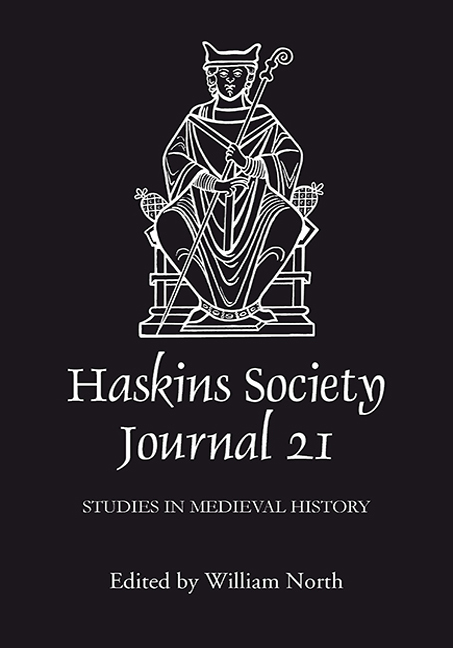Book contents
- Frontmatter
- Contents
- Editor's Note
- Abbreviations
- 1 Bede and the Rewriting of Sanctity
- 2 The Role of Rivers and Coastlines in Shaping Early English History
- 3 Containing Virginity: Sex and Society in Early Medieval England
- 4 Pagans and Infidels, Saracens and Sicilians: Identifying Muslims in the Eleventh-Century Chronicles of Norman Italy
- 5 Robert Curthose and the Norman Episcopate
- 6 The Revival of Roman Law: the Exceptiones Petri
- 7 Mutatis Mutandis: Literary Borrowing from Jerome's Letter to Eustochium and Others in the Life of Blessed Bernard of Tiron by Geoffrey Grossus
- 8 Acting Out Friendship: Signs and Gestures of Aristocratic Male Friendship in the Twelfth Century
- 9 The Quantification of Assarted Land in Mid- and Late Twelfth-Century England
- 10 Origins of Courtliness after 25 Years
9 - The Quantification of Assarted Land in Mid- and Late Twelfth-Century England
Published online by Cambridge University Press: 28 April 2017
- Frontmatter
- Contents
- Editor's Note
- Abbreviations
- 1 Bede and the Rewriting of Sanctity
- 2 The Role of Rivers and Coastlines in Shaping Early English History
- 3 Containing Virginity: Sex and Society in Early Medieval England
- 4 Pagans and Infidels, Saracens and Sicilians: Identifying Muslims in the Eleventh-Century Chronicles of Norman Italy
- 5 Robert Curthose and the Norman Episcopate
- 6 The Revival of Roman Law: the Exceptiones Petri
- 7 Mutatis Mutandis: Literary Borrowing from Jerome's Letter to Eustochium and Others in the Life of Blessed Bernard of Tiron by Geoffrey Grossus
- 8 Acting Out Friendship: Signs and Gestures of Aristocratic Male Friendship in the Twelfth Century
- 9 The Quantification of Assarted Land in Mid- and Late Twelfth-Century England
- 10 Origins of Courtliness after 25 Years
Summary
One of the major themes in English landscape history in the period between the Domesday survey and the opening of the fourteenth century has been the story of the clearance of woodland, the drainage of marshlands, and the colonization of the uplands. This theme emerged as a key concept under the influence of the work of Wilhelm Abel and M.M. Postan. They argued that the response to the inexorable rise of population in the twelfth and thirteenth centuries was to extend the frontiers of cultivation into previously unoccupied lands. Much work on this subject was undertaken in the 1950s and 1960s when historians charted the work of peasants in carving out holdings from the woods, the details of the construction of embankments in the wetlands, and the foundation of Cistercian granges in the uplands. This view was central to many of the papers in the second volume of the Agricultural History of England and Wales published in 1988, which traced the growth of agricultural land in the period before 1350.
In more recent years, there has been a growing body of cautious, and even thoroughly revisionist, work casting doubt on the Postanian view of agricultural expansion. The most influential was Mark Bailey's critique of the concept of the margins of agriculture, but that was only one of a number of papers which began to question the interpretation.
Important criticisms of Postan's view of agricultural expansion have arisen in three particular areas. The first was raised by Postan's contemporary, Reginald Lennard, who argued that by the eleventh century England was no longer a frontier society with large, untouched wastes. Instead, he thought that England should be viewed as an ‘old country’ where, though ‘the population was, no doubt, very scanty and the area of wood, waste, and marsh, very large, Anglo-Saxon farmers were not nibbling the edges of a wilderness that was still unsubdued’. His description of Domesday England was carefully qualified: ‘villages, hamlets or farmstead were to be found throughout the length and breadth of the country, and even the waste and wood were not wholly unutilized, but provided supplies of firewood, timber and game’. This view of the countryside was heavily influenced by Lennard's consideration of the Domesday figures. Drawing upon earlier work by F.W. Maitland, Lennard noted that there were 71,785 ploughteams in the twenty-eight counties for which we have reliable records.
- Type
- Chapter
- Information
- The Haskins Society Journal 212009. Studies in Medieval History, pp. 165 - 186Publisher: Boydell & BrewerPrint publication year: 2010



